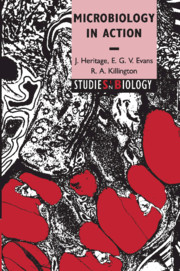Book contents
- Frontmatter
- Contents
- Preface
- 1 The microbiology of soil and of nutrient cycling
- 2 Plant–microbe interactions
- 3 The microbiology of drinking water
- 4 Microbial products
- 5 Food microbiology
- 6 The human commensal flora
- 7 Microbial infections
- 8 Chemotherapy and antibiotic resistance
- Further reading
- Glossary
- Index
2 - Plant–microbe interactions
Published online by Cambridge University Press: 05 June 2012
- Frontmatter
- Contents
- Preface
- 1 The microbiology of soil and of nutrient cycling
- 2 Plant–microbe interactions
- 3 The microbiology of drinking water
- 4 Microbial products
- 5 Food microbiology
- 6 The human commensal flora
- 7 Microbial infections
- 8 Chemotherapy and antibiotic resistance
- Further reading
- Glossary
- Index
Summary
What are mycorrhizas?
The name mycorrhiza is derived from two Greek words, mukes meaning a mushroom and rhiza, a root, illustrating a very important mutualistic interrelationship between plants and fungi. These partnerships have a long history. The fossil record shows that fungi and higher plants have lived in the close association of mycorrhizal relationships for at least 400 million years. The first recorded observations of mycorrhizal associations were made in the mid-nineteenth century. The numbers of plants that form mutualistic associations with fungi perhaps best illustrates the importance of mycorrhizal relationships. Over 80% of higher plants and ferns grow in association with a fungal partner. The range of higher plants affected include hard- and softwood trees, shrubs and other flowering plants as well as grasses.
The fungi that form mycorrhizal partnerships greatly extend the active surface area of the root system of plants. Fungi replace and extend the root system of the plant. The roots of trees that carry mycorrhizas are typically short and dichotomously branched. Unaffected roots are much longer. Orchids have evolved to such a degree that their mycorrhizal fungi have even replaced the plant root hairs. Plants that support mycorrhizas have much greater access to inorganic nutrients, particularly nitrates, phosphates and water. In return, the plant partner supplies its fungus with a source of organic nutrients and, in many cases, vitamins.
- Type
- Chapter
- Information
- Microbiology in Action , pp. 16 - 35Publisher: Cambridge University PressPrint publication year: 1999



